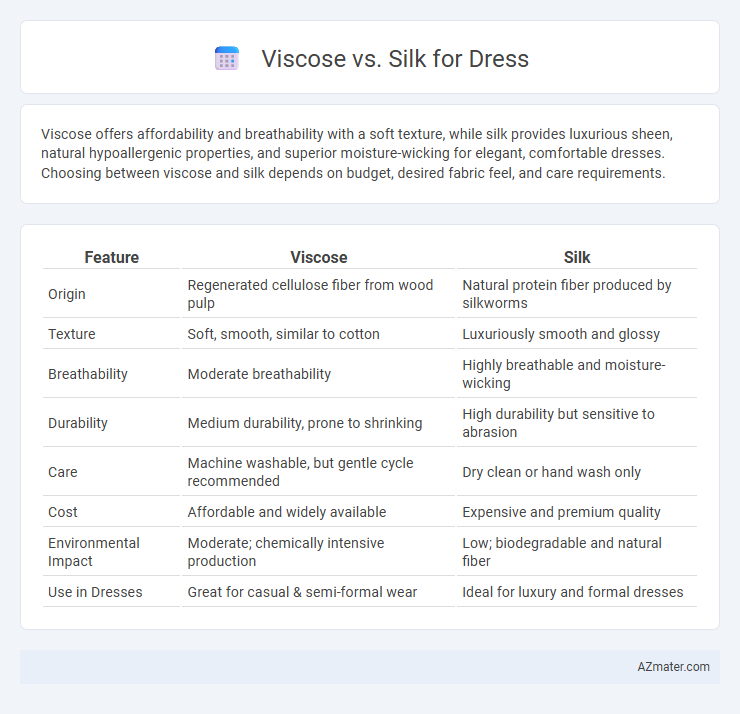Viscose offers affordability and breathability with a soft texture, while silk provides luxurious sheen, natural hypoallergenic properties, and superior moisture-wicking for elegant, comfortable dresses. Choosing between viscose and silk depends on budget, desired fabric feel, and care requirements.
Table of Comparison
| Feature | Viscose | Silk |
|---|---|---|
| Origin | Regenerated cellulose fiber from wood pulp | Natural protein fiber produced by silkworms |
| Texture | Soft, smooth, similar to cotton | Luxuriously smooth and glossy |
| Breathability | Moderate breathability | Highly breathable and moisture-wicking |
| Durability | Medium durability, prone to shrinking | High durability but sensitive to abrasion |
| Care | Machine washable, but gentle cycle recommended | Dry clean or hand wash only |
| Cost | Affordable and widely available | Expensive and premium quality |
| Environmental Impact | Moderate; chemically intensive production | Low; biodegradable and natural fiber |
| Use in Dresses | Great for casual & semi-formal wear | Ideal for luxury and formal dresses |
Introduction to Viscose and Silk
Viscose, a semi-synthetic fiber derived from cellulose, offers a breathable and soft texture similar to natural fabrics, making it popular for affordable yet elegant dress materials. Silk, a natural protein fiber produced by silkworms, is renowned for its luxurious sheen, smooth feel, and excellent draping qualities, often preferred for high-end and formal dresses. Understanding the distinct properties of viscose and silk helps in selecting the ideal fabric based on budget, comfort, and desired appearance for dresses.
Origin and Production Process
Viscose, a semi-synthetic fiber derived from wood pulp primarily sourced from beech, pine, and eucalyptus trees, undergoes a chemical process involving cellulose extraction, purification, and regeneration through viscose solution extrusion. Silk originates from the natural protein fiber produced by silkworms, primarily the Bombyx mori species, through a cocoon-spinning process harvested and carefully reeled for fabric production. While viscose involves industrial chemical treatment for fiber formation, silk retains its natural, protein-based origin with a labor-intensive, natural extraction process.
Texture and Feel Comparison
Viscose offers a smooth, soft texture with a lightweight, breathable feel that drapes well, making it comfortable for everyday wear. Silk boasts a natural sheen with an exceptionally smooth and luxurious texture, providing a cool, silky feel against the skin that enhances elegance. While viscose feels more casual and matte, silk delivers a premium, glossy finish with superior softness and moisture-wicking properties.
Breathability and Comfort
Viscose offers excellent breathability due to its natural cellulose fibers, making it ideal for warm-weather dresses by allowing air circulation and moisture absorption. Silk, while luxurious and smooth against the skin, is less breathable than viscose, trapping heat and moisture under certain conditions. For maximum comfort in hot climates, viscose provides superior airflow and moisture-wicking properties compared to silk, which excels more in temperature regulation during cooler environments.
Durability and Longevity
Silk offers exceptional durability and longevity due to its natural protein fibers, maintaining strength even when wet and resisting wrinkling and pilling. Viscose, while soft and luxurious, has less tensile strength and tends to weaken with repeated washing and wear, leading to a shorter lifespan in dresses. Choosing silk ensures a more resilient and long-lasting garment compared to the delicate nature of viscose fibers.
Cost and Affordability
Viscose offers an affordable alternative to silk for dresses, with prices typically ranging from $10 to $30 per yard compared to silk's $50 to $100 per yard, making it accessible for budget-conscious shoppers. While silk is prized for its luxurious texture and natural sheen, its higher cost often limits its use to special occasions or high-end fashion. Viscose mimics the softness and drape of silk at a fraction of the cost, providing a cost-effective option without sacrificing comfort or style.
Environmental Impact
Viscose production involves significant deforestation and chemical use, leading to habitat loss and water pollution, whereas silk farming requires mulberry cultivation and produces biodegradable fibers with a lower carbon footprint. Silk's natural biodegradability and renewable resource status make it a more sustainable option compared to viscose, which relies on intensive wood pulp processing. Choosing silk can reduce environmental harm by minimizing chemical waste and supporting eco-friendly farming practices.
Care and Maintenance
Viscose dresses require gentle washing, preferably hand wash or delicate cycle with cold water to prevent shrinking and loss of texture, while silk dresses demand even more careful handling with mild detergents and often dry cleaning to maintain their natural sheen and softness. Avoid exposing viscose to high heat during drying or ironing, as it can deform fibers, whereas silk should be ironed on a low setting with a cloth barrier to avoid burns and preserve fabric integrity. Proper storage in a cool, dry place away from direct sunlight helps both viscose and silk dresses retain their color and extend overall garment lifespan.
Best Uses for Dresses
Viscose is ideal for casual and affordable dresses due to its lightweight, breathable, and drapey qualities, offering comfort in warm weather. Silk excels in elegant or formal dresses, providing a luxurious sheen, smooth texture, and natural temperature regulation. For everyday wear, viscose offers versatility and easy care, while silk is best suited for special occasions requiring a sophisticated appearance.
Choosing Between Viscose and Silk
Viscose and silk are popular dress materials with distinct characteristics influencing choice. Viscose offers affordability, breathability, and ease of care, making it suitable for casual or everyday wear. Silk stands out for its luxurious texture, natural sheen, and hypoallergenic properties, ideal for formal occasions and premium dress designs.

Infographic: Viscose vs Silk for Dress
 azmater.com
azmater.com